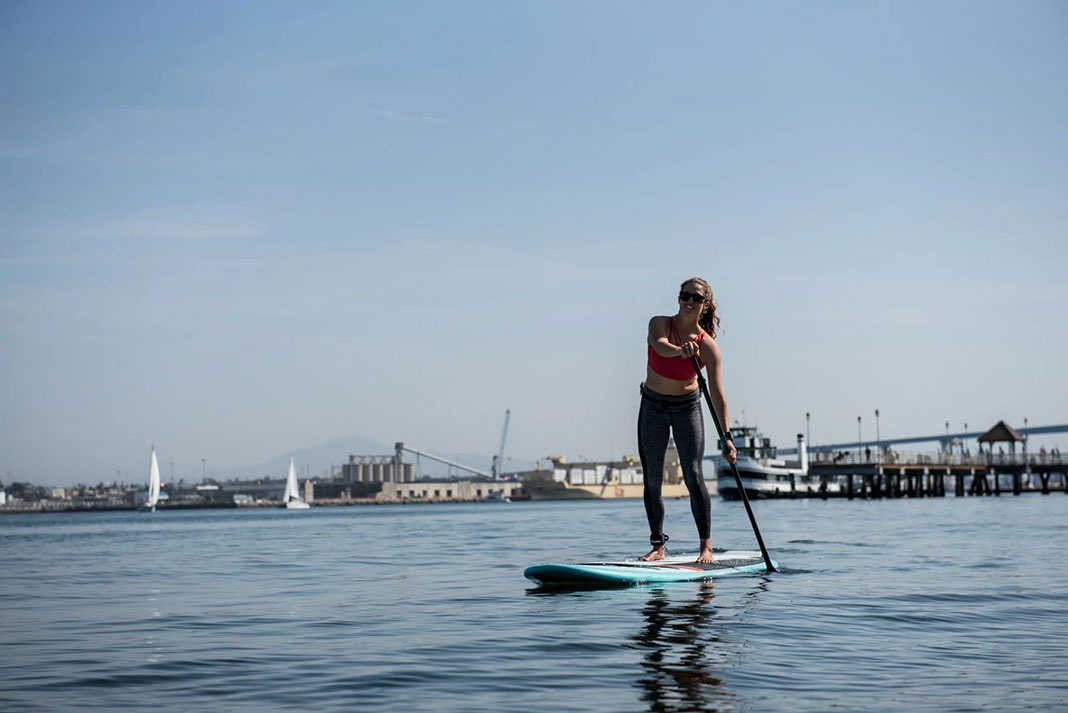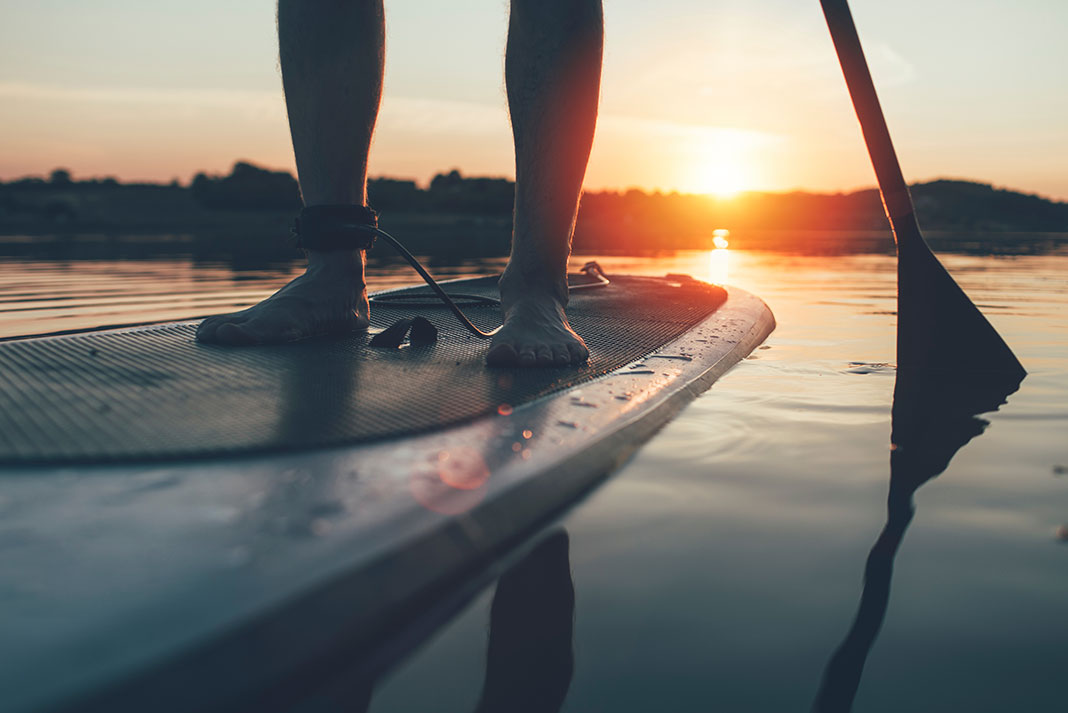Choosing a paddleboard size isn’t just about the board; it’s about what you want to get out of it. A perfectly sized paddleboard should carry your weight efficiently, perform well for the type of paddling you’re doing and provide enough stability for your skill level so you have an enjoyable session.
This paddleboard size guide will look at paddleboard dimensions and paddleboard size recommendations to help you answer the question, what size paddleboard should I get?
What sizes do paddleboards come in?
Paddleboards come in many shapes and sizes. The most popular recreational paddleboards for general use are typically 10 to 11 feet in length and between 32 and 34 inches wide. However, paddleboards for solo use can range from under nine feet to more than 14 feet long, and from less than 25 inches to more than 36 inches wide. This range encompasses different skill levels, types of paddling and body types.
Within any given board category, there is a range of board sizes with different sizes that correspond to different rider weights. This is because taller and heavier paddlers will need a higher volume board for float and stability, which may mean longer, broader or thicker dimensions. If you’re buying a board that will be shared, get the size appropriate for the largest and least experienced person who will use it. Ultimately, the way a board performs is a combination of all its design features, plus the paddler’s weight, ability and water conditions. Read on to meet your perfect match.
Paddleboard length

Length refers to the measurement from nose to tail of a board, and it plays a vital role in how a board handles. In general, longer boards are faster, while shorter boards are slower but more maneuverable. Because shorter boards are more responsive, they’re favored by some for surf conditions. For groms just starting out, consider a specific kids paddleboard.
Under 10 feet
- Best for smaller paddlers (under 150 lbs), including youth
- Better maneuverability
- More responsive for SUP surf
Around 11 feet
- Average length for most recreational SUP styles
- Suited to all-around use
- Suitable for beginner to advanced skill level
Over 12 feet
- Longer designs are more efficient for touring and racing
- Better suited to paddlers with more experience—there’s more board to handle—and larger paddlers
Paddleboard width

Width is the measurement from rail to rail at the broadest part of the board. A wider board is more stable but it will be slower. A narrower board offers less resistance and better glide but less stability. In general, a smaller person will enjoy paddling a narrower board, which will help avoid reaching over a wide board to get the paddle in the water. A larger person will feel more stable on a wider board.
Under 30 inches
- The narrower the board, the less stable and more paddling experience needed
- Elite athletes race boards as narrow as 19 inches wide
30–32 inches
- Average paddleboard width
- Touring boards are usually in this range
- Good middle ground between speed and stability
32–34 inches and up
- Increased width creates more stability, better for bigger paddlers
- Offers more space to carry gear or your pup
- Around 32 to 34 inches is a stable width for whitewater, fishing and SUP yoga
Paddleboard thickness

Thickness is the measurement of depth at the widest part of the board. Thickness affects the volume therefore weight capacity of a board. Inflatable designs are often an inch thicker than hard boards of the same category, and thickness may be a factor in increasing the rigidity of some inflatable paddleboards.
Under 5 inches
- Average thickness for hard SUPs
- While there are some iSUPs in this category, for SUP surf or youth, make sure they are produced by a reputable brand making high-quality boards
5–6 inches
- Thicker may be better for bigger paddlers because it adds weight capacity
- Average thickness for an inflatable SUP
6 inches and up
- Longer touring and racing boards benefit from extra thickness to prevent bowing in the middle of the board
- Extra thickness creates more volume—helpful for paddlers 200+ lbs
- Raises center of gravity
- Takes longer to inflate
Paddleboard volume

The volume of a board is determined by its length, width, thickness and shape. Volume, measured in liters, determines a board’s buoyancy and how much weight it can float. A lower volume board means a lower weight capacity. A higher volume board means a higher weight capacity. A similarly shaped board with higher volume feels more stable, making it ideal for new and/or larger paddlers.
Rather than having to guess what a board’s volume means for you, manufacturers post a recommended weight range specific for each model. Don’t forget to factor in your gear and any pets or kids who may be paddling with you. It’s better to err on the side of a board that’s a little too big than a board that’s too small.
Below 170 Liters
- Getting into SUP surf board territory
- For smaller paddlers
- For more experienced paddlers
170–190 Liters
- Average hard SUP volume range for beginner paddlers
220–280 Liters
- Average inflatable SUP volume range for beginner paddlers
Above 280 Liters
- Offers increased weight capacity for heavier paddlers or more cargo
- Usually a bigger board for yoga, racing, touring or whitewater
Paddleboards for plus-size paddlers
Is there a weight limit for paddleboards? You can have fun on a paddleboard no matter your size or weight. There’s a board out there for every weight range. If you’re wondering, “What size paddleboard do I need?”, the important thing is ensuring whatever board you choose has a weight capacity that exceeds your weight and the weight of the gear, pets or kids you bring. You can’t be too light for a paddleboard, but you can be too heavy for a specific model. Exceeding the weight capacity of your board results in reduced stability, speed and glide and can make for a poor paddling experience.
Paddleboard size charts and calculators
If you are curious about how to determine standup paddleboard size, many SUP calculators are available online to factor in a paddler’s weight and spit back paddleboard size recommendations. However, these paddleboard size guides are generalizations at best. There’s no secret formula to finding the perfect board. The best place to begin is to identify which category of board suits the paddling you’ll do most often, and then identify the boards that suit your weight, rather than prematurely getting stuck on dimensions.
Best size paddleboard for beginners
That said, Red Bull SUP athlete Casper Steinfath offers this advice: “If you are a beginner paddling on mixed water without much experience, I would suggest looking for a board at least 32 inches wide that carries volume equivalent to at least 2.5 liters times your weight in kilos.”
In other words, a 70-kilogram rider, for example, should seek out a 32-inch or wider board with a minimum volume of 175 liters.
When sizing a paddleboard, a paddler’s height is a far less important consideration than the paddler’s weight and the combined weight of the paddler and gear they expect to carry. However, height may be a consideration for very tall paddlers, who have a higher center of gravity and therefore may be more comfortable on a slightly wider and more stable board.
Choosing a size is just the beginning of finding a good beginner paddleboard. Don’t buy a board without understanding hull types, fin systems, differences between hard boards and inflatable SUPs, SUP construction, and other unique details.





